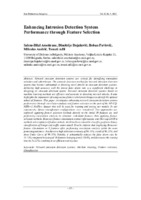Enhancing Intrusion Detection System Performance through Feature Selection

Megtekintés/
Metaadat
Teljes megjelenítés
Link a dokumentumra való hivatkozáshoz:
Gyűjtemény
Absztrakt
Network intrusion detection systems are critical for identifying anomalous
activities and cyberthreats. The anomaly detection method for network intrusion detection
systems has become substantial in detecting novel attacks in intrusion detection systems.
Achieving high accuracy with the lowest false alarm rate is a significant challenge in
designing an intrusion detection system. Network intrusion detection systems based on
machine learning methods are effective and accurate in detecting network attacks. It also
highlights the importance of using various feature selection techniques to identify the optimal
subset of features. This paper investigates enhancing network intrusion detection systems
performance through correlation analysis and feature selection on the part of the NF-UQ-
NIDS-v2 NetFlow dataset that will be used for training and testing our models. In our
experiments, binary classification configurations were considered. Two approaches are
explored: applying feature selection methods directly to the initial 39 features set, and
performing correlation analysis to eliminate redundant features then applying feature
selection methods. Recursive feature elimination, mutual information, and One-way ANOVA
methods select optimized feature subsets. An ExtraTrees ensemble classifier performs binary
classification of benign and traffic under attack. Results indicate that employing Recursive
feature elimination on 8 features after performing correlation analysis yields the most
promising outcomes. It achieves a high detection accuracy of 98.13%, recall of 98.23%, and
Area Under Curve of 99.73%. Notably, it substantially reduces the false alarm rate by
53.73% compared to using all 39 features bringing it to 0.3589%, and decreases the scoring
time by 34.21%, resulting in an efficient scoring time.
- Cím és alcím
- Enhancing Intrusion Detection System Performance through Feature Selection
- Szerző
- Amokrane, Salem-Bilal
- Bujaković, Dimitrije
- Pavlović, Boban
- Andrić, Milenko
- Adli, Touati
- Megjelenés ideje
- 2025
- Hozzáférés szintje
- Open access
- ISSN, e-ISSN
- 1785-8860
- Nyelv
- en
- Terjedelem
- 20 p.
- Tárgyszó
- network intrusion detection system, machine learning, feature selection, classification
- Változat
- Kiadói változat
- Egyéb azonosítók
- DOI: 10.12700/APH.22.1.2025.1.10
- A cikket/könyvrészletet tartalmazó dokumentum címe
- Acta Polytechnica Hungarica
- A forrás folyóirat éve
- 2025
- A forrás folyóirat évfolyama
- 22. évf.
- A forrás folyóirat száma
- 1. sz.
- Műfaj
- Tudományos cikk
- Tudományterület
- Műszaki tudományok - anyagtudományok és technológiák
- Egyetem
- Óbudai Egyetem
